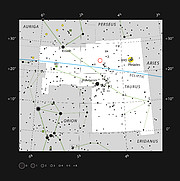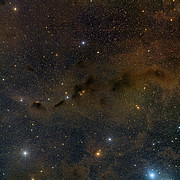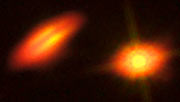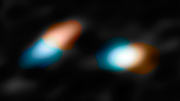Press Release
ALMA Finds Double Star with Weird and Wild Planet-forming Discs
30 July 2014
Astronomers using the Atacama Large Millimeter/submillimeter Array (ALMA) have found wildly misaligned planet-forming gas discs around the two young stars in the binary system HK Tauri. These new ALMA observations provide the clearest picture ever of protoplanetary discs in a double star. The new result also helps to explain why so many exoplanets — unlike the planets in the Solar System — came to have strange, eccentric or inclined orbits. The results will appear in the journal Nature on 31 July 2014.
Unlike our solitary Sun, most stars form in binary pairs — two stars that are in orbit around each other. Binary stars are very common, but they pose a number of questions, including how and where planets form in such complex environments.
“ALMA has now given us the best view yet of a binary star system sporting protoplanetary discs — and we find that the discs are mutually misaligned!” said Eric Jensen, an astronomer at Swarthmore College in Pennsylvania, USA.
The two stars in the HK Tauri system, which is located about 450 light-years from Earth in the constellation of Taurus (The Bull), are less than five million years old and separated by about 58 billion kilometres — this is 13 times the distance of Neptune from the Sun.
The fainter star, HK Tauri B, is surrounded by an edge-on protoplanetary disc that blocks the starlight. Because the glare of the star is suppressed, astronomers can easily get a good view of the disc by observing in visible light, or at near-infrared wavelengths.
The companion star, HK Tauri A, also has a disc, but in this case it does not block out the starlight. As a result the disc cannot be seen in visible light because its faint glow is swamped by the dazzling brightness of the star. But it does shine brightly in millimetre-wavelength light, which ALMA can readily detect.
Using ALMA, the team were not only able to see the disc around HK Tauri A, but they could also measure its rotation for the first time. This clearer picture enabled the astronomers to calculate that the two discs are out of alignment with each other by at least 60 degrees. So rather than being in the same plane as the orbits of the two stars at least one of the discs must be significantly misaligned.
“This clear misalignment has given us a remarkable look at a young binary star system,” said Rachel Akeson of the NASA Exoplanet Science Institute at the California Institute of Technology in the USA. “Although there have been earlier observations indicating that this type of misaligned system existed, the new ALMA observations of HK Tauri show much more clearly what is really going on in one of these systems.”
Stars and planets form out of vast clouds of dust and gas. As material in these clouds contracts under gravity, it begins to rotate until most of the dust and gas falls into a flattened protoplanetary disc swirling around a growing central protostar.
But in a binary system like HK Tauri things are much more complex. When the orbits of the stars and the protoplanetary discs are not roughly in the same plane any planets that may be forming can end up in highly eccentric and tilted orbits [1].
“Our results show that the necessary conditions exist to modify planetary orbits and that these conditions are present at the time of planet formation, apparently due to the formation process of a binary star system,” noted Jensen. “We can’t rule other theories out, but we can certainly rule in that a second star will do the job.”
Since ALMA can see the otherwise invisible dust and gas of protoplanetary discs, it allowed for never-before-seen views of this young binary system. “Because we’re seeing this in the early stages of formation with the protoplanetary discs still in place, we can see better how things are oriented,” explained Akeson.
Looking forward, the researchers want to determine if this type of system is typical or not. They note that this is a remarkable individual case, but additional surveys are needed to determine if this sort of arrangement is common throughout our home galaxy, the Milky Way.
Jensen concludes: “Although understanding this mechanism is a big step forward, it can’t explain all of the weird orbits of extrasolar planets — there just aren’t enough binary companions for this to be the whole answer. So that’s an interesting puzzle still to solve, too!”
Notes
[1] If the two stars and their discs are not all in the same plane, the gravitational pull of one star will perturb the other disc, making it wobble or precess, and vice versa. A planet forming in one of these discs will also be perturbed by the other star, which will tilt and deform its orbit.
More information
The Atacama Large Millimeter/submillimeter Array (ALMA), an international astronomy facility, is a partnership of Europe, North America and East Asia in cooperation with the Republic of Chile. ALMA is funded in Europe by the European Southern Observatory (ESO), in North America by the U.S. National Science Foundation (NSF) in cooperation with the National Research Council of Canada (NRC) and the National Science Council of Taiwan (NSC) and in East Asia by the National Institutes of Natural Sciences (NINS) of Japan in cooperation with the Academia Sinica (AS) in Taiwan. ALMA construction and operations are led on behalf of Europe by ESO, on behalf of North America by the National Radio Astronomy Observatory (NRAO), which is managed by Associated Universities, Inc. (AUI) and on behalf of East Asia by the National Astronomical Observatory of Japan (NAOJ). The Joint ALMA Observatory (JAO) provides the unified leadership and management of the construction, commissioning and operation of ALMA.
This research was presented in a paper entitled “Misaligned Protoplanetary Disks in a Young Binary Star System”, by Eric Jensen and Rachel Akeson, to appear in the 31 July 2014 issue of the journal Nature.
The team is composed of Eric L. N. Jensen (Dept. of Physics & Astronomy, Swarthmore College, USA) and Rachel Akeson (NASA Exoplanet Science Institute, IPAC/Caltech, Pasadena, USA).
ESO is the foremost intergovernmental astronomy organisation in Europe and the world’s most productive ground-based astronomical observatory by far. It is supported by 15 countries: Austria, Belgium, Brazil, Czechia, Denmark, France, Finland, Germany, Italy, the Netherlands, Portugal, Spain, Sweden, Switzerland and the United Kingdom. ESO carries out an ambitious programme focused on the design, construction and operation of powerful ground-based observing facilities enabling astronomers to make important scientific discoveries. ESO also plays a leading role in promoting and organising cooperation in astronomical research. ESO operates three unique world-class observing sites in Chile: La Silla, Paranal and Chajnantor. At Paranal, ESO operates the Very Large Telescope, the world’s most advanced visible-light astronomical observatory and two survey telescopes. VISTA works in the infrared and is the world’s largest survey telescope and the VLT Survey Telescope is the largest telescope designed to exclusively survey the skies in visible light. ESO is the European partner of a revolutionary astronomical telescope ALMA, the largest astronomical project in existence. ESO is currently planning the 39-metre European Extremely Large optical/near-infrared Telescope, the E-ELT, which will become “the world’s biggest eye on the sky”.
Links
- Research paper
- NRAO press release about HK Tauri results
- Image of HK Tauri from the NASA/ESA Hubble Space Telescope
- More about ALMA
- Photos of ALMA
- Videos of ALMA
- ALMA brochure
- The movie ALMA — In Search of our Cosmic Origins
- The ALMA Photo Book In Search of our Cosmic Origins – The Construction of the Atacama Large Millimeter/submillimeter Array
- More press releases with ALMA
Contacts
Eric L. N. Jensen
Lead Scientist, Swarthmore College
Philadelphia, USA
Tel: +1 610-328-8249
Email: ejensen1@swarthmore.edu
Rachel Akeson
NASA Exoplanet Science Institute, IPAC/Caltech
Pasadena, USA
Tel: +1 626-395-1812
Email: rla@ipac.caltech.edu
Charles E. Blue
Public Information Officer, National Radio Astronomy Observatory
Charlottesville, USA
Tel: + 1 434 296 0314
Cell: +1 202 236 6324
Email: cblue@nrao.edu
Richard Hook
Public Information Officer, ESO
Garching bei München, Germany
Tel: +49 89 3200 6655
Cell: +49 151 1537 3591
Email: rhook@eso.org
About the Release
| Release No.: | eso1423 |
| Name: | HK Tauri |
| Type: | Milky Way : Star : Grouping : Binary Milky Way : Star : Circumstellar Material |
| Facility: | Atacama Large Millimeter/submillimeter Array |
| Science data: | 2014Natur.511..567J |
Our use of Cookies
We use cookies that are essential for accessing our websites and using our services. We also use cookies to analyse, measure and improve our websites’ performance, to enable content sharing via social media and to display media content hosted on third-party platforms.
ESO Cookies Policy
The European Organisation for Astronomical Research in the Southern Hemisphere (ESO) is the pre-eminent intergovernmental science and technology organisation in astronomy. It carries out an ambitious programme focused on the design, construction and operation of powerful ground-based observing facilities for astronomy.
This Cookies Policy is intended to provide clarity by outlining the cookies used on the ESO public websites, their functions, the options you have for controlling them, and the ways you can contact us for additional details.
What are cookies?
Cookies are small pieces of data stored on your device by websites you visit. They serve various purposes, such as remembering login credentials and preferences and enhance your browsing experience.
Categories of cookies we use
Essential cookies (always active): These cookies are strictly necessary for the proper functioning of our website. Without these cookies, the website cannot operate correctly, and certain services, such as logging in or accessing secure areas, may not be available; because they are essential for the website’s operation, they cannot be disabled.
Functional Cookies: These cookies enhance your browsing experience by enabling additional features and personalization, such as remembering your preferences and settings. While not strictly necessary for the website to function, they improve usability and convenience; these cookies are only placed if you provide your consent.
Analytics cookies: These cookies collect information about how visitors interact with our website, such as which pages are visited most often and how users navigate the site. This data helps us improve website performance, optimize content, and enhance the user experience; these cookies are only placed if you provide your consent. We use the following analytics cookies.
Matomo Cookies:
This website uses Matomo (formerly Piwik), an open source software which enables the statistical analysis of website visits. Matomo uses cookies (text files) which are saved on your computer and which allow us to analyze how you use our website. The website user information generated by the cookies will only be saved on the servers of our IT Department. We use this information to analyze www.eso.org visits and to prepare reports on website activities. These data will not be disclosed to third parties.
On behalf of ESO, Matomo will use this information for the purpose of evaluating your use of the website, compiling reports on website activity and providing other services relating to website activity and internet usage.
Matomo cookies settings:
Additional Third-party cookies on ESO websites: some of our pages display content from external providers, e.g. YouTube.
Such third-party services are outside of ESO control and may, at any time, change their terms of service, use of cookies, etc.
YouTube: Some videos on the ESO website are embedded from ESO’s official YouTube channel. We have enabled YouTube’s privacy-enhanced mode, meaning that no cookies are set unless the user actively clicks on the video to play it. Additionally, in this mode, YouTube does not store any personally identifiable cookie data for embedded video playbacks. For more details, please refer to YouTube’s embedding videos information page.
Cookies can also be classified based on the following elements.
Regarding the domain, there are:
- First-party cookies, set by the website you are currently visiting. They are stored by the same domain that you are browsing and are used to enhance your experience on that site;
- Third-party cookies, set by a domain other than the one you are currently visiting.
As for their duration, cookies can be:
- Browser-session cookies, which are deleted when the user closes the browser;
- Stored cookies, which stay on the user's device for a predetermined period of time.
How to manage cookies
Cookie settings: You can modify your cookie choices for the ESO webpages at any time by clicking on the link Cookie settings at the bottom of any page.
In your browser: If you wish to delete cookies or instruct your browser to delete or block cookies by default, please visit the help pages of your browser:
Please be aware that if you delete or decline cookies, certain functionalities of our website may be not be available and your browsing experience may be affected.
You can set most browsers to prevent any cookies being placed on your device, but you may then have to manually adjust some preferences every time you visit a site/page. And some services and functionalities may not work properly at all (e.g. profile logging-in, shop check out).
Updates to the ESO Cookies Policy
The ESO Cookies Policy may be subject to future updates, which will be made available on this page.
Additional information
For any queries related to cookies, please contact: pdprATesoDOTorg.
As ESO public webpages are managed by our Department of Communication, your questions will be dealt with the support of the said Department.







